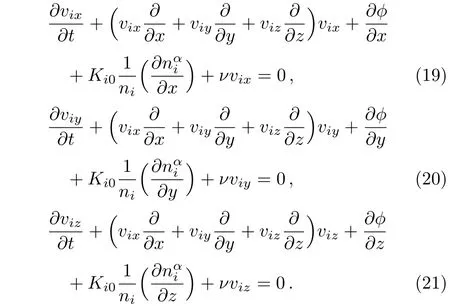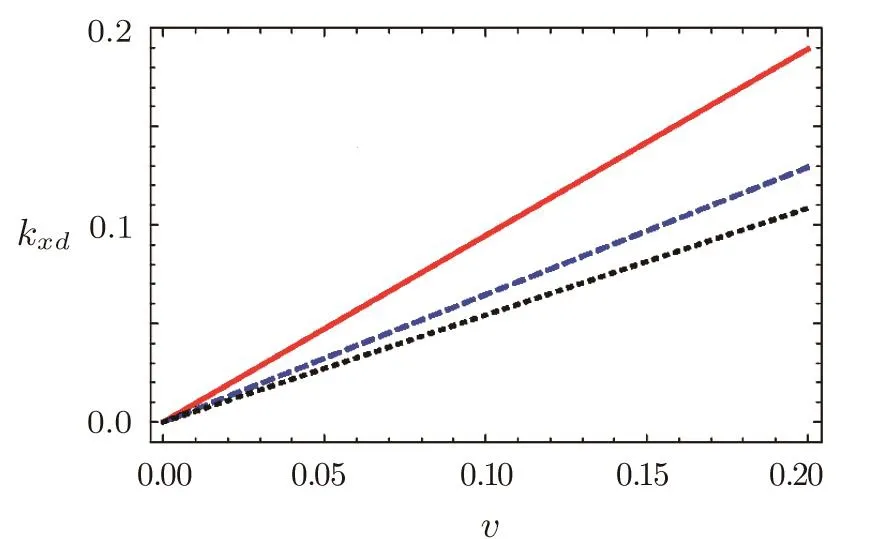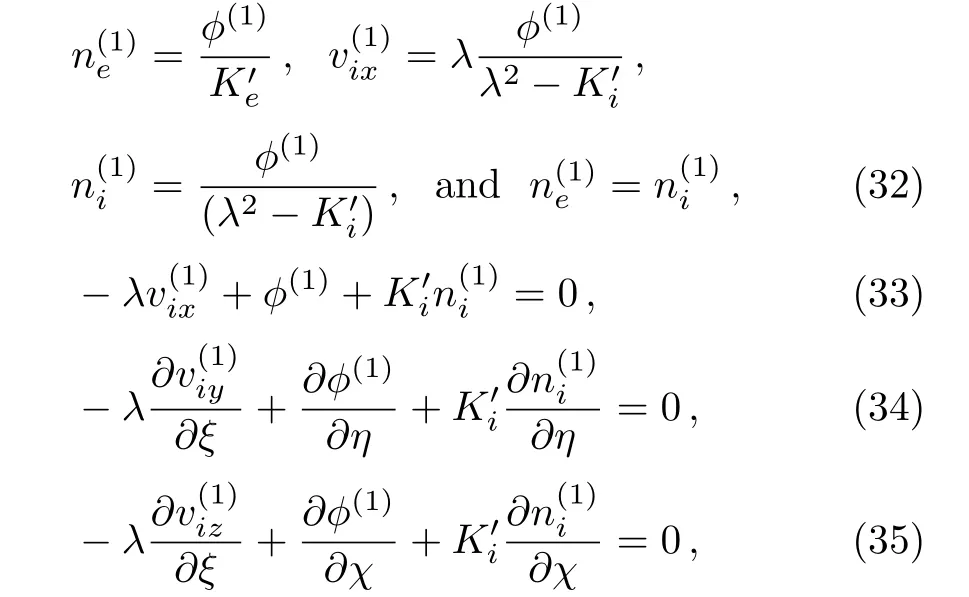Damped Kadomtsev–Petviashvili Equation for Weakly Dissipative Solitons in Dense Relativistic Degenerate Plasmas
S.AhmadAta-ur-RahmanS.A.Khanand F.Hadi
1Department of Physics,University of Kotli Azad Jammu and Kashmir,11100 Kotli,Pakistan
2Department of Physics,Theoretical Plasma Physics Group,Islami a College Peshawar(A Public SectorUniversity),Peshawar 25120,Pakistan
3National Centre for Physics,Quaid-i-Azam University Campus,Islamabad 43520,Pakistan
4Department of Nuclear Engineering,Kyoto University,Kyoto 615-8540,Japan
5Department of Applied Physical and Material Sciences,University of Swat,Swat 19200,Pakistan
1 Introduction
Rapid advancements in physics and technology have made it possible to create plasma conditions in Earthbound laboratories that previously existed only in the unattainable regimes like interiors of stars and planets.[1]However,plasma behavior in this case is exotic and its description challenging.Additional complexities arise in plasmas under extreme conditions of density,temperature and magnetic field abundant in astrophysical and cosmological environments like white and brown dwarfs and neutron stars/magnetars.[2−5]Here,the plasmas are not only super-dense but quantum degenerate and relativistic as well.Such coexistence of plasma effects and quantum degeneracy is now well known in plasmas in strong laser field,[6]laboratory experiments on super-intense laser–solid target interactions,[7−8]fast ignition scheme,[9]and high energy density plasmas.[10−11]
Quantum effects become prominent when electron thermal de Broglie wavelengthλBe= ħ/mevte(where ħ =h/2πwithhbeing the Planck’s constant,meis the electron mass andvteis the electron thermal velocity)approaches to or becomes larger than the average interelectron separation(∼n−1/3e,nebeing the electron number density).Such a situation occurs when the plasma is cooled down to a very low temperature,or plasma density is increased to an extremely high level.Under such circumstances,the Pauli exclusion principle dictates that no two half-integral spin particles(fermions)can stay simultaneously in the same quantum state,so a large number of electrons are pushed into the higher(degenerate)energy states,which is commonly called the electron degeneracy.At this stage the electrons follow Fermi–Dirac distribution function and Fermi degeneracy pressure becomes dominant.As the de Broglie wavelength denotes the spatial extension of particle wave function,so the larger it is,the more dominant quantum effects will be.From the de finition ofλBit is evident that the quantum character of lighter species(electron,positron etc.)is more pronounced due to their smaller masses as compared to the heavier species like ions.
In ultra-dense dynamical environments where the number density is extremely high,the electron Fermi energy is signi ficant in comparison to the electron rest mass energy.Consequently on the Fermi surface,the speed of electron becomes comparable to that of speed of light in vacuum and one can no longer ignore both the quantum and relativistic effects.[4,12]Matter under such condition of extreme density shows stronger quantum degeneracy,for instance in case of white dwarf stars the average bulk density can be∼1030cm−3or even higher.[13]
Chandrasekhar for the first time formulated a mathematical relation as an equation of state to describe the degeneracy pressure in such dense compact objects for two limits,i.e.,non-relativistic(P∝n5/3)and ultra-relativistic(P∝n4/3)limit.[14−15]He found that the Fermi degeneracy pressure will only keep the white dwarf star stable if its mass is less than a critical value estimated to be 1.4 solar masses,which is known as Chandrasekhar mass.Above this limit,the Fermi degeneracy pressure becomes insufficient to counter balance the catastrophic inward gravitational pull,[16]and collapse occurs.This pressure plays vital role in collective oscillations in relativistic and degenerate plasmas are very short scales.[17−18]In such plasma environments,when the amplitude of oscillation becomes reasonably large,then one must take the nonlinear effects into account,which shows the possibility of formation of localized nonlinear structures(solitons and shocks).Among various types of electrostatic nonlinear waves,solitons are of particular interest for many researchers as they provide with a good physical insight to incorporate the dynamic processes underlying the nonlinear phenomena.One-dimensional soliton can be modeled via the well known Korteweg-de Vries(KdV)equation or Sagdeev pseudopotential approach.In a two-dimensional system,the soliton was first modeled by Kadomstev and Petviashvili[19]via a two-dimensional partial differential equation for cold plasma system which is a multi-dimensional extension of the well-known KdV equation.Numerous studies[20−23]have been reported regarding KP equation for different plasma environments using various plasma compositions.Applications in relativisticdegenerate plasmas include study of the ion waves with low and arbitrary amplitude in a relativistically degenerate plasma[24]and geometry effects of on the evolution of the electrostatic potential and possibility of rogue waves in low amplitude limit.[25]
It is noteworthy to mention here that all these investigations so far have been done without taking the collisional(dissipative)effects into account,which posses the characteristics of an integrable system(as a subclass of the Hamiltonian system)and is an extreme simpli fication of the real plasmas in nature.However with inclusion of the dissipative effects,the plasma remains no longer Hamiltonian and nonlinear localized structures in such type of non-Hamiltonian systems are known as dissipative solitons.[26−27]In addition to the interplay between nonlinearity and dispersion,which is necessary for the formation of a solitary wave structure in an integrable system,a balance between gain and loss should exist to have a dissipative nonlinear localized structure.[28]New features of dispersion and nonlinearity in dissipative longitudinal solitons in a 2D system have been pointed out in a complex plasma.[29]It is therefore tempting to search for the role of dissipative effects due to plasma-neutral collisions on the propagation of ion solitary waves.Inspired by the current interest in the dissipative solitons which link the dissipative solitons paradigm to plasma dynamics,we have undertaken an investigation of the dissipative solitons propagating in degenerate dense plasmas.It is worth mentioning that the present paper investigates for the first time the effects of transverse perturbations as well as the dissipative effects on the existence and propagation of ion solitary structures in a degenerate dense plasma by deriving a damped KP equation governing the dynamics of three dimensional dissipative solitons.
This paper is arranged in the following fashion.The mathematical model and linear wave analysis are presented in Sec.2.The derivation of the damped KP equation along with its steady state and approximate time varying solutions are given in Sec.3.The results are numerically simulated in Sec.4,while Sec.5 is dedicated to recapitulate the entire study.
2 Mathematical Model
Let us consider a dense unmagnetized collisional plasma where the electrons are assumed to be ultrarelativistically degenerate while the ions as non-relativistic and degenerate.Then,the degeneracy parameter forith species follows that κj>1,where κj=εFj/Tj=1/2(3π2)2/3(n0λBj)2/3,which is a ratio of the Fermi energy to the thermal energy.In order to emphasize the dissipative effects,the collisions of both ions and electrons with the neutral particles are included and are represented by the simple relaxation term[30]in their respective momentum balance equations.The normalized electron momentum equation can be written as

The Bohm potential term can in fact be neglected if we consider length scales much larger than the mean interparticle distance so that quantum statistical pressure dominates over the quantum diffraction effects.For typical values of various plasma parameters,the ion thermal pressure in white dwarf stars is much smaller in comparison with the electron degeneracy pressure and the ions can be considered as cold.The ion momentum balance equation can be expressed as

In Eqs.(1)and(2),nj,vj,mj,vj,andϕ,respectively,denote the number density, fluid velocity,mass and plasmaneutral collisional frequency,wherej=ifor ions andj=efor electrons.The ultra-relativistic degenerate electrons are assumed to follow the equation of state of the form

Here the polytropic indexγ=4/3(for ultra-relativistic case)andKe=3/4(π2/9)1/3ħc≃(3/4)ħcwith ħ =h/2π.Furthermore,the ions are assumed to obey the equation of state given as:


and the polytropic index isα=5/3(for non-relativistic of quantum and relativistic effects in our model.We are interested in low frequency where the electrons being the lighter particles respond very quickly to the electric field and acquire equilibrium faster than the heavier plasma species like ions.To show this let us introduce the following rescaling


where the characteristic velocity scale(quantum ionconvenience the tildes notation(∼)is dropped in the remainder of this work.The normalized electron momentum Eq.(1)takes the form





In this particular case of interest the plasma dynamics is three-dimensional and therefore we assume that∇=(∂x,∂y,∂z).Then above system of equations takes the form


Similarly,the components of normalized ion momentum conservation equation(Eq.(8))can be expressed as

While the continuity equation(Eq.(9))and the Poisson’s equation(Eq.(10))take the following forms

2.1 Linear Mode Analysis
A linear dispersion relation can be readily obtained by linearizing Eqs.(15)–(23)in the form

whereK′e=γKe0,andK′i=αKi0.We have assumed thexdirection as the predominant direction for the propagation of waves due to weak transverse perturbations alongyandzdirections,such thatkx≫kyandkz.
In the absence of collisions(i.e.,υ→0)Eq.(24)reduces to the usual dispersion relation for ion waves in a relativistic degenerate superdense plasma.[31]However,one can further solve the dispersion relation(24)for complex frequency and realkx,by settingω=ωr+iωi,which gives


It is clear that|ωi|is independent ofkxand it gives the damping(dissipation)rate(υdiss),such thatυdiss∼|ωi|∼υ=vi/ωpi.It is straightforward to note that the ionneutral collisional frequency determines the system dissipation rate.We further assume weak ion-neutral collisionυ≪1 which implies thatυi≪ωpi,i.e.,the ion-neutral collisional frequency is smaller than the characteristic ion plasma frequency.Since the system dissipation rate(υdiss)is low in comparison with the characteristic oscillation frequency(ωpi),therefore the model under consideration is a weakly dissipative degenerate dense plasma system.Furthermore,the appearance of collisionality parameter in Eq.(26)clearly manifests that the linear wave properties are strongly effected by electron(ion)-neutral collisions.The effect of plasma con figurational parameters such as collisional frequency and equilibrium plasma number density(throughK′eandK′i)on linear wave pro file is depicted in Figs.1 and 2.

Fig.1 Variation of ωrversus kxfor different values of collisional frequency,i.e.,ν=0(solid line),ν=0.02(dashed line)and ν=0.06(dotted line).Other parameters used are n0=1030cm−3,α =5/3,and γ =4/3.

Fig.2 Variation of the wavenumber threshold kxdwith ν,for different values of equilibrium plasma number density,i.e.,n0=1029cm−3(solid line),n0=5×1029cm−3(dashed line)and n0=1030cm−3(dotted line).Other parameters are α =5/3 and γ =4/3.
From Fig.1 it can be seen that for each value of collisional frequency the wavenumberkxhas a threshold value below which the wave is over-damped or in other words the propagation is not possible.It is seen that the real part of the wave frequency decreases asνincreases(see Fig.1).From Eq.(26)one can easily derive the relation for the critical value(kxd)given below:

The variation ofkxdwithνfor different values of unperturbed plasma number density is shown in Fig.3.In the long wavelength limitk2xK′e≪1,Eq.(25)yields the following relation for wave phase speed


Fig.3 The time evolution of solitons for different val-
3 Derivation of Damped KP Equation
Toderivethenon-lineardamped KP equation,we make use of the standard reductive perturbation method.[32−33]In this regard,following stretching of independent space and time coordinates can be introduced

whereλis the wave phase velocity normalized by quantum ion-sound speedCi,and is to be determined later.Further,ϵis a smallness real parameter(0<ϵ<1)specifying the amplitude of perturbation and is proportional to the strength of nonlinearity.The normalized physical variablesni,ne,vix,viy,viz,andϕare expanded as:

Notice that the transverse components(vjy,vjz)of the ion fluid speed appear to evolve more slowly(at higher order inϵ)than the parallel velocity componentvjx.



The next order inϵgives the following set of equations


The latter equation demands that in order to make the perturbation expansion consistent with that of Eqs.(30)and(31),and also to incorporate dissipative effects resulting form the ion-neutral collisions,it is necessary to take the following scaling

which clearly justi fies the fact that the ion-neutral collisional rate(νi)is much smaller than the characteristic plasma frequency(ωpi)as assumed in the model under consideration.After the above substitution,Eq.(39)can be arranged as

In order to eliminate the second order perturbed quantities,we solve Eqs.(36)–(38)and(41)–(45)while making use of Eq.(32)and arrive at the following expression

Further substituting the values ofG1,G4,G7andG8into Eq.(46)as well as using the first-order quantities,we obtain an evolution equation in the form of damped KP equation,

It is immediately noticed that Eq.(51)is in complete agreement with Eq.(26)i.e.,the system dissipation(damping)rate Γ∼ν/2∼|ωi|.In damped KP equation(Eq.(47)),the term “Γϕ”is the representative of dissipative effect caused by ion-neutral collisions,the so called“damping term”.It is worth mentioning here that the presence of lowest order nonlinear and dispersion terms restrict the KP equation to describe only a wave of small amplitude.For large amplitude waves,the width and velocity do not remain consistent with the predictions of KP equation,which causes its breakdown.In the absence of plasma-neutral collisions,i.e.,Γ=0,Eq.(47)reduces to the usual KP equation for the system under consideration.The usual KP equation(without dissipative term)is completely integrable or in other words,the energy of the system is conserved.[34]To show this mathematically,we assume the predominant propagation of wave along the parallel direction.Now we multiply Eq.(47)(with Γ =0)byϕ(ξ,τ)and then integrate the resultant expression within the limit(−∞,∞)subjected to the vanishing boundary conditions,i.e.,ϕ(ξ,τ)and all its derivatives upto second order→0 asξ→±∞.In this way the following energy conservation equation is obtained,


whereNandW,respectively,represent the amplitude and spatial width of the soliton.The relevant soliton parametersW,N,andUare related through the expressions

It can be seen directly from Eq.(54)that the solitary waves increase in amplitude with an increase in velocity,while the corresponding spatial width decreases such thatNW2=12B/A=constant,for a fixed value of equilibrium plasma number density(n(0)).However,in the presence of dissipative effects(i.e.,Γ/=0),Eq.(47)does not represent a completely integrable system,or in other words the energy is not conserved.The energy equation(52)in this case becomes

Thus,the KP equation(Eq.(47))in the presence of linear damping term(Γϕ)cannot be solved analytically.However,an approximate solution can be found using the soliton perturbation technique,[26−27]provided that the system dissipation rate is small.We employ the same technique and find the time evolution solution of damped KP equation,using the leading-order approximation.As the presence of damping causes the deformation of solitary structure,so its amplitude,width and velocity become time dependent,such thatN=N(τ),W=W(τ),U=U(τ).In this way the leading-order one-soliton solution of the damped KP equation with Γ∼O(ϵ3/2)results


In Eqs.(57)and(58)N(0)&ε(0)are,respectively,the initial soliton amplitude and energy.The soliton velocity and width can be expressed,respectively,as

4 Numerical Analysis
The time varying solutions presented above are approximate leading-order solutions and the reason is obvious i.e.,we have restricted our analysis to the first order inϵonly.However the analysis holds well for perturbations exhibiting dissipation.[26,35]All the higher orders in the perturbation scheme introduce only corrections to the leading-order solution.But these corrections do not affect the change in soliton parameters,which results from the damping.Thus the soliton’s amplitude,width and velocity change in the same manner as found in leadingorder solution.The exponentially decaying behavior of soliton amplitudeN(τ),energyε(τ)and velocityU(τ)with time due to the presence of dissipative effects is clearly manifested by Eqs.(57)–(59)respectively.However,Eq.(60)shows that the soliton spatial width grows exponentially with time,but the product of amplitude(N(τ))and square of width(W2(τ))always remains the same(i.e.,N(τ)W2(τ)=12B/A=constant)for a particular case.The numerical solutions exactly show similar behavior as presented in Figs.3 and 4.


Fig.4 The evolution of solitons for varying values of Γ,i.e.,Γ =0.01(a),Γ =0.017(b),and Γ =0.024(c).We have taken the equilibrium plasma number density n0=1030cm−3,whereas the initial condition and other related parameters are the same as used in Fig.3.
5 Conclusions
Summing up,we have investigated the linear and nonlinear characteristics of ion solitary waves in a weakly dissipative dense plasma system comprising of ultrarelativistic degenerate electrons and non-relativistic degenerate ion fluids.In the present study,we have mainly focused on the damping of ion solitary waves,which is caused by the ion-neutral collisional effect.For weakly nonlinear approximation,the damped KP equation is derived by using standard reductive perturbation approach.The analytical and numerical results support the formation and propagation of compressive solitons undergoing weak dissipation with time.We have shown that the plasma number density and ion-neutral collisional rate signi ficantly affect the soliton’s amplitude,width and velocity.Further,for numerical analysis,we have used the typical values of various plasma parameters relevant to interior of white dwarfs,reported in Ref.[12].
The present study aims to be helpful in understanding the different aspects of localized nonlinear disturbances in dense plasma environments such as in white dwarf stars.Owing to the colossal number densities in the interior of white dwarfs,the electrons become relativistically degenerate through the implication of both Pauli’s exclusion mechanism and Heisenberg uncertainty principle,such that their quantum mechanical nature elucidates the equation of state as well as their structure and mass limitation.[4]
[1]M.G.Haines,P.D.LePell,C.A.Coverdale,B.Jones,C.Deeney,and J.P.Apruzese,Phys.Rev.Lett.96(2006)075003.
[2]G.Chabrier,F.Douchin,and A.Y.Potekhin,J.Phys.Condens.Matter 14(2002)9133.
[3]F.C.Michel,Rev.Mod.Phys.54(1982)1.
[4]S.L.Shapiro and S.A.Teukolsky,Black Holes,White Dwarfs,and Neutron Stars:The Physics of Compact Objects,John Wiley and Sons,New York(1983).
[5]H.Gursky,Forntiers of Astrophysics,Harvard University Press,London(1976)
[6]D.Kremp,Th.Bornath,M.Bonitz,and M.Schlanges,Phys.Rev.E 60(1999)4725.
[7]J.Lindl,Phys.Plasmas 2(1995)3933.
[8]S.X.Hu and C.H.Keitel,Phys.Rev.Lett.83(1999)4709.
[9]P.T.Leon,S.Eleizer,M.Piera,and J.M.M.Val,inCurrent Trends in Inertial Fusion Research-Proceedings of the Fifth Symposium,eds.E.Panarella and R.Raman,NRC Research Press,Ottawa,Canada(2008)
[10]R.P.Drake,Phys.Plasmas 16(2009)055501.
[11]S.H.Glenzer and R.Redmer,Rev.Mod.Phys.81(2009)1625.
[12]D.Koester and G.Chanmugam,Rep.Prog.Phys.53(1990)837.
[13]P.K.Shukla and B.Eliasson,Rev.Mod.Phys.83(2011)885.
[14]S.Chandrasekhar,An Introduction to the Study of Stellar Structure,University of Chicago Press,Chicago(1939)
[15]S.Chandrasekhar,Mon.Not.R.Astron.Soc.170(1935)405.
[16]G.Fontaine and F.Wesemae,in Encyclopedia of Astronomy and Astrophysics,ed.P.Murdin,Nature,New York(2001)
[17]H.D.Sivak,Physica A 129(1985)408.
[18]S.A.Khan,K.Ayub,and A.Ahmad,Phys.Plasmas 19(2012)102104.
[19]B.B.Kadomtsev and V.I.Petviashvili,Sov.Phys.Dokl.15(1970)539.
[20]G.C.Das and K.M.Sen,Contrib.Plasma Phys.33(1993)15.
[21]W.S.Duan,Chaos,Solitons and Fractals 14(2002)503.
[22]S.K.El-Labany,W.M.Moslem,W.F.El-Taibany,and M.Mahmood,Phys.Scr.70(2004)317.
[23]H.Rehman,S.A.Khan,W.Masood,and M.Siddiq,Phys.Plasmas 15(2008)124501.
[24]I.Zeba,W.M.Moslem,and P.K.Shukla,Astrophys.J.750(2012)72.
[25]A.Rahman,S.Ali,W.M.Moslem,and A.Mushtaq,Phys.Plasmas 20(2013)072103.
[26]V.I.Karpman and E.M.Maslov,Sov.Phys.JETP 46(1977)281.
[27]R.L.Herman,J.Phys.A 23(1990)2327.
[28]S.Ghosh and N.Chakrabarti,Phys.Rev.E 84(2011)046601.
[29]D.Samsonov,A.V.Ivlev,R.A.Quinn,G.Mor fill,and S.Zhdanov,Phys.Rev.Lett.88(2002)095004.
[30]F.Haas and A.Bret,Europhys.Lett.97(2012)26001.
[31]L.Nahar,M.S.Zobaer,N.Roy,and A.A.Mamun,Phys.Plasmas 20(2013)022304.
[32]H.Washimi and T.Taniuti,Phys.Rev.Lett.17(1966)996.
[33]R.C.Davidson,Methods in Nonlinear Plasma Theory,Academic,New York(1972).
[34]V.Yu.Belashov and S.V.Vladimirov,Solitary Waves in Dispersive Complex Media,Springer-Verlag,Berlin(2005)
[35]A.C.Newell,Solitons in Mathematics and Physics,SIAM,Philadelphia,Penn(1985)
[36]S.I.Popel,A.P.Golub,T.V.Losseva,A.V.Ivlev,S.A.Khrapak,and G.Mor fill,Phys.Rev.E 67(2003)056402.
 Communications in Theoretical Physics2017年12期
Communications in Theoretical Physics2017年12期
- Communications in Theoretical Physics的其它文章
- Linear Analysis of Obliquely Propagating Longitudinal Waves in Partially Spin Polarized Degenerate Magnetized Plasma
- In finite Conservation Laws,Continuous Symmetries and Invariant Solutions of Some Discrete Integrable Equations∗
- New Exact Traveling Wave Solutions of the Unstable Nonlinear Schrodinger Equations
- General Solutions for Hydromagnetic Free Convection Flow over an In finite Plate with Newtonian Heating,Mass Diffusion and Chemical Reaction
- Anti-synchronization Between Two Coupled Networks with Unknown Parameters Using Adaptive and Pinning Controls∗
- In fluence of Cell-Cell Interactions on the Population Growth Rate in a Tumor∗
